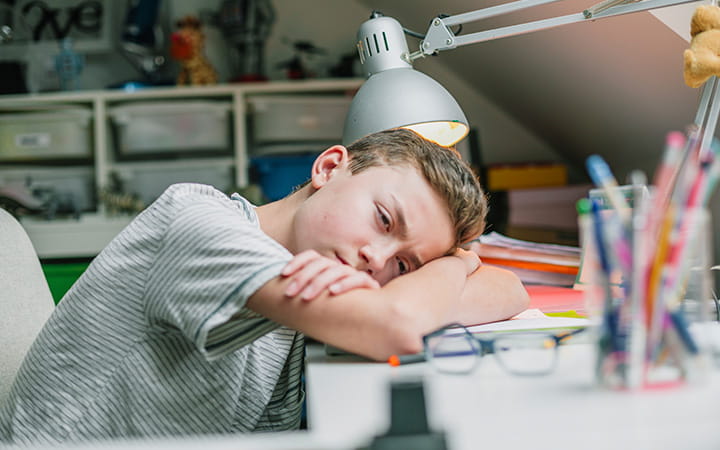General Anxiety Disorder in Kids: When Worry and Fear Doesn't Go Away
June 16, 2021
 University Hospitals Rainbow Babies & Children'sExperts in Children's Health
University Hospitals Rainbow Babies & Children'sExperts in Children's Health

Generalized anxiety disorder is a mental health problem. A child with generalized anxiety disorder has a lot of worry and fear that may be more intense than expected.
Anxiety disorders are common and affect about one in 10 children. Children or teens with generalized anxiety disorder often worry about many things, such as:
- Physical appearance
- Future events
- Past behaviors
- Social acceptance
- Family matters
- Failing to meet parents' expectations
- Their personal abilities
- School performance
“All children and teens have some anxiety. It's a normal part of growing up,” says UH Rainbow pediatric psychologist Rebecca Hazen, PhD, who specializes in pediatric development and behavior. “But sometimes worries and fears don’t go away. They may interfere with a child’s normal activities. In these cases, an anxiety disorder may be present.”
Generalized Anxiety Disorder Causes
Experts believe generalized anxiety disorder is caused by biological and environmental factors. A child may inherit a tendency to be anxious. An imbalance of two chemicals in the brain, norepinephrine and serotonin, most likely plays a part.
A child can also learn anxiety and fear from family members and others. For example, a child with a parent who is afraid of thunderstorms may learn to fear thunderstorms.
“A traumatic event may also cause generalized anxiety disorder,” Dr. Hazen says. “This can include things such as the death of a parent, a divorce, or a serious family accident or illness.”
Symptoms of Generalized Anxiety Disorder
“Unlike adults with generalized anxiety disorder, children and teens often don’t realize that their anxiety is more intense than the situation calls for,” Dr. Hazen says. “Children and teens with generalized anxiety disorder often need a lot of reassurance from the adults in their life.”
Symptoms may be a bit different for each child. But the most common symptoms of generalized anxiety disorder are:
- Many worries about things before they happen
- Many worries about friends, school or activities
- Almost constant thoughts and fears about the child’s safety or the parents’ safety
- Refusing to go to school
- Frequent stomachaches, headaches, or other physical complaints
- Muscle aches or tension
- Sleep problems
- Lots of worry about sleeping away from home
- Clingy behavior with family members
- Feeling as though there is a lump in the throat
- Extreme tiredness
- Lack of concentration
- Being easily startled
- Being grouchy or irritated
- Inability to relax
The symptoms of generalized anxiety disorder may seem like other health problems. Make sure your child sees a healthcare provider for a diagnosis.
Treatment for Generalized Anxiety Disorder
“Children and teens with generalized anxiety disorder can’t get better without help. They don't choose to act or feel anxious,” Dr. Hazen says. “In many cases, treatment is key to recovery. Untreated, generalized anxiety disorder can get worse and become a lifelong problem. Seventy percent of adults with anxiety disorders report that their symptoms began in childhood. ”
Treatment will depend on your child’s symptoms, age and general health. It will also depend on how severe the condition is. Options include:
- Cognitive behavioral therapy --This helps a child learn how to better manage anxiety. The goal is also to help a child master the situations that may lead to the anxiety.
- Medicines -- Antidepressant or anti-anxiety medicine may help some children.
- Family therapy -- Parents play a vital role in any treatment.
- School input -- A child’s school may also be included in care.
When To Call a Health Care Provider
Call your child's healthcare provider right away if your child:
- Feels extreme depression, fear, anxiety or anger toward himself or herself or others
- Feels out of control
- Hears voices that others don’t hear
- Sees things that others don’t see
- Can’t sleep or eat for three days in a row
- Shows behavior that concerns friends, family or teachers, and others express concern about this behavior and ask you to get help
“Parents and caregivers need to know that generalized anxiety disorder may increase a child’s risk for suicide. Threats of suicide are a cry for help. Always take such statements, thoughts, behaviors, or plans very seriously,” Dr. Hazen says. “Any child who expresses thoughts of suicide should be evaluated right away.”
Call 9-1-1 if your child has suicidal thoughts, a suicide plan and the means to carry out the plan.
If your child is older, make sure they have emergency numbers in their phone,” Dr. Scherer says. These would include parents, other trusted adults, their healthcare provider, and the National Suicide Prevention Lifeline at 800-273-8255.
“Help your child understand that reaching out for help is the most important thing to do if self-harm is being considered,” she says.
Related Links
Many children and adolescents have emotional difficulties and the majority of them never get the help they need. When a child doesn't get the help he needs, emotional difficulties can sometimes lead to more serious psychological trauma, and in severe cases, even to a lifetime of confusion, hardship, and pain. Our team at the Rainbow Division of Child and Adolescent Psychiatry provides a full scope of psychiatric evaluation and treatment services, either directly or through referral to affiliated staff and programs. Learn more about child and adolescent psychiatry services at UH Rainbow.


